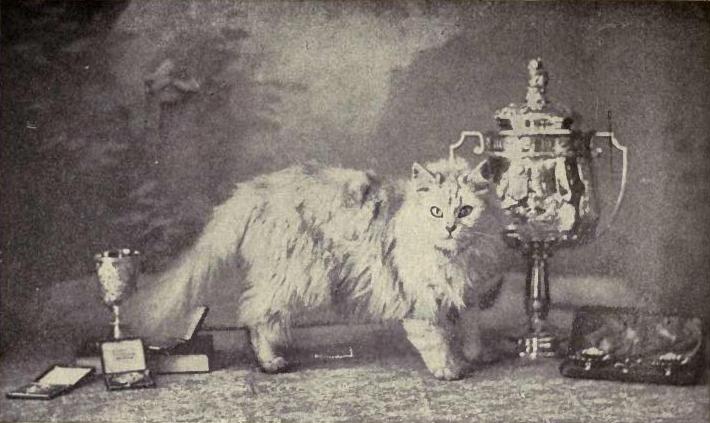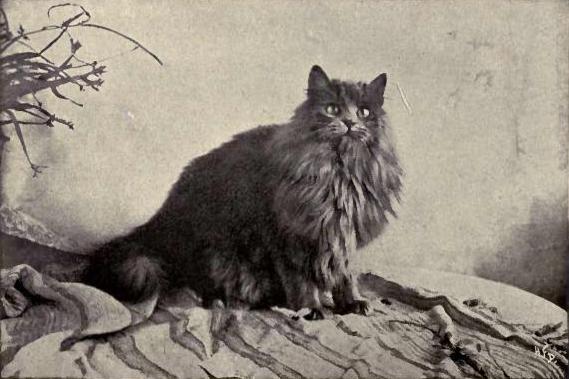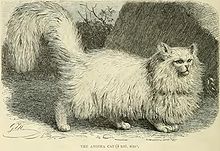
Fancy Feast YouTube 1
Short Version
Fancy Feast YouTube 3
Fancy Feast YouTube 2
"The Engaement" extended version
NEW!!!



Silver Persian / Angora Origins
The silver Persian was created by mixing the original white angora with the blue Persians, which is why you can have both types of fur in the same litter; the angora being silky vs. the persian being cotton-like.
English: Persian/Angora from 1894. Caption says Angora, but text uses both terms interchangeably. (1894)
The Royal Natural History Vol 1 Richard Lydekker
Blue Persian "Gentian" owned by Lady Marcus Beresford.Prize-winner at Westminster in 1899.
"CHAMPION FULMER ZAIDA is the renowned Silver female owned by Lady Decies. This cat has won more prizes than any other in the Fancy, numbering over 150. Zaida is almost an unmarked specimen, and her colour is wonderfully pure. She has carried off the highest honours at all the leading shows, and will probably continue to win whenever exhibited"September 1902 ("Cats and All About Them" by Frances Simpson)
Dorothy Bevill Champion lays out the difference between the two types in the 1909 Everybody's Cat Book:
Our pedigree imported long-hairs of to-day are undoubtedly a cross of the Angora and Persian ; the latter possesses a rounder head than the former, also the coat is of quite a different quality. The coat of the Persian consists of a woolly under coat and a long, hairy outer coat. In summer it loses all the thick underwool, and only the long hair remains. The hair is also somewhat shorter on the shoulders and upper part of the hind legs.
Now, the Angora has a very different coat, consisting of long, soft hair, hanging in locks, inclining to a slight curl or wave on the under parts of the body. The hair is also much longer on the shoulders and hind legs than the Persian, this being a great improvement; but the Angora fails to the Persian in head, the former having a more wedge-shaped head, whereas that of the modern Persian excels in roundness.
Of course. Angoras and Persians have been constantly crossed, with a decided improvement to each breed; but the long-haired cat of to-day is decidedly more Persian-bred than Angora.

EARLY HISTORY OF THE CHINCHILLA
by Professor K W Bentley
Source: CATS Magazine no 818, 21 November 1997, Official Journal of the GCCF, who reprinted this article with permission from "The Journal" of the Chinchilla, Silver Tabby & Smoke Cat Society (Issue 3), 1978.
The Chinchilla is essentially a manufactured breed, developed to a distinctive variety by patient, selective breeding over many years. Whereas the early Silver Tabbies and Smokes possessed the essential characteristics of the present day cats (though they differed markedly in type!) the earliest recognizable progenitors of the Chinchilla would hardly be recognizable as ancestors of the cats that are currently to be seen on the show bench.
The origin of the breed is, however, well documented, and all lines have been ultimately developed from one cat, a female called Chinnie, born in 1882. It was uncertain whether the name "Chinnie" was given to this cat because the term "Chinchilla" was already in use or whether the later term was introduced as a variant of her vague resemblance of the Chinchilla rabbit or the rodent of that name.
The colour of Chinnie's parents has not been recorded and no photographs of her survive. It seems likely that she was therefore a mackerel striped Silver Tabby or even a long-haired spotted tabby (another form known in short-haired show cats but not at the present day in the long-haired form). Weak markings in such patterns would give something vaguely resembling the product of a cross between today's Chinchilla and Blue.
Chinnie was bred by Mrs. Hurt of Sandal Mayner near Wakefield. The identities of her parents are not known, though her dam was bred from prize winning parents and her sire from a brought cat and an itinerant tom cat of uncertain type who was a transient resident in Babbicombe. She was bought by Mrs. Vallance, and was apparently regarded as sufficiently unusual by the standard of the day for her owner to try to perpetuate her colouring by mating her to a suitable male. Such a mate was found in Fluffy I (parents again unknown, but bred in 1883 by Miss Acland from imported cats), "a very pure Silver with undecided tabby markings", who won first prize and medals in the Silver Class at Maidstone, Cheltenham and Ealing, and second prize at Ryde. The record of the next few years is a catalogue of hopes raised only to be wrecked by fate that must be familiar to many who have ever laid plans for breeding.
The mating of Fluffy I and Chinnie in 1885 produced a male, Vezzoso and a female, Beauty, later to be known as Beauty of Bridgyate. Vezzoso became Best in Show at the Albert Palace in 1885, was first in the Silver class at Louth and Maidstone, second at Frome and third at Lincoln. He refused to be properly domesticated, however, and (like his maternal grandfather, the stray cat of Babbicombe) disappeared in 1886.
The mating between Chinnie and Fluffy I was repeated in 1886 and produced Fluffy II, who took first place at crystal Palace, Best in Show at Brighton and second place at the Albert Palace and Ealing shows, before dying from injuries received in an accident in 1887. Fluffy I also disappeared in 1886 so the only surviving product of this famous mating by 1887 was Beauty. She was bought as a kitten by Miss Howe of Bridgyate near Bath and subsequently, by a breeding arrangement with the Misses Gresham (later Mrs. Bridgwater and Mrs. Balding), had three litters of kittens.
The first by Rahman (who later strayed from home and was lost) yielded four queens, one of which went to America and the rest died. From that time onwards, greater success attended these efforts, and the next mating of Beauty, which was with a Smoke, Mrs. Shearman's Champion Perso, gave the legendary Ch Silver Lambkin, who is generally regarded as the first Chinchilla. Once this cat matured the breeding and perfection of the Chinchilla was undertaken with enthusiasm, with the result that the first class for this breed alone was instituted at the Crystal Palace Show in 1894.
Beauty of Bridgyate's involvement did not, however, end with the birth of Silver Lambkin. She was mated for the third time to Bonny Boy, a good Silver Tabby, who was Best in Show at Bridhton in 1892 and sold to the Hon Mrs. McLaren Morrison, who re-registered him with the name Nizan and made him a Champion. This mating produced one male and four females. Of the females, one was sold as Lambkin Queen to Mrs. Martin and two, I, Beauty's Daughter and Twin (so named because they were almost indistinguishable and won prizes wherever shown), were retained by Mrs. Balding. Twin was eventually sold to Mr. Lawton and renamed "Queen of the Mist" but she subsequently died after swallowing a needle.
I, Beauty's Daughter was mated to two Blues. One of these matings (to Ch Bundle) gave Southampton, and the other (Glaucus) gave Burah. Lord Southampton was a popular stud cat in the 1890s, but the Stud Books do not allow the identification of any descendants of his after the First World War, though it is probable that some have been carried forward into post war lines though cats that won no Stud Book entry.
Burah in turn was mated to Silver Lambkin's son, Sliver Owl (ex Silver Dawn, herself the daughter of Lambkin Queen by Puff) to give Girlie. The last-named queen when mated to Kohinoor (a son of Lord Argent, was Silver Lambkin's son ex Sylvie, a very lightly marked Silver of unrecorded ancestry) produced Rob Roy of Arrandale, who appears to be an ancestor of every Chinchilla line in the country today .
These matings seem complicated when described chronologically above and clearly involve much in-breeding, the extent of which may be more readily appreciated when set out as a family tree, which spans a period of 13 years from the birth of Beauty of Bridgyate in 1885 to that of Rob Roy of Arradale in 1898.
By that time, sufficient new blood had been introduced by crossing with Blues, Silver Tabbies and others (the family tree set out below is, of course, only part of what was done in those years) to give a range of lines for the further development of the breed.
These matings to establish the Chinchilla had two interesting results. The first was that from the (presumably) mackerel striped Chinnie and the (presumably) blotched patterned Nizam, as well as from the non-agouti Perso, Bundle and Glaucus, both mackerel striped and blotched tabby genes were introduced into the earliest Chinchilla and have remained generally distributed in the population ever since, and both patterns can be seen on newly born kittens. With only vestigail ticking in today's cats it is virtually impossible to distinguish between the two patterns after about ten weeks.
The second consequences is that from the Blues, Ch Bundle and Glaucus the recessive gene for blue dilution was introduced (and indeed probably was introduced into other stock not mentioned above) and this would lead inevitably to the production of cats (at least 25% in subsequent mating of carrier of blue dilution) with blue rather than black ticking. This raises the interesting question of whether the original Chinchilla had blue ticking and there is some evidence to suggest that they did.
Frances Simpson, writing in her "Book of The Cat" in 1903, talked of the coat of the Chinchilla shading to "a short of bluish lavender to the tips of the coat", adding, "I think that it is the delicate tips of silvery-blue that lend such a charm and give such distinction to this variety". Elsewhere in the same book, Mrs. Balding (breeder of Silver Lambkin) wrote, "Colour, in Chinchilla, is the most important point. It should be of palest silver, lavender tint and lighter - in fact practically white - at the roots ". Frances Simpson also quotes C.A. House as saying, "pure silver is of a bluish tinge", and Mrs. Leslie Williams in her book, "The Cat - Its Care and Management" (1907) says of the Chinchilla or "self-silver":"A good self-silver has fur that is white at the roots and shades softly to a faint gray at the tips. The colour is rather that of old-fashioned silver lustre ware than of modern silver. The ideal self-silver must have neither markings nor shadings, nor must there be any black tips to the hair, either oh the back of in the tail or elsewhere".
Early standards of points did not specifically mention the colour of the tipping, but in 1930 the standard referred to it as "black".
During this early period, cats were produced with a range of levels of tipping, as is indeed still the case today, and judges were never sure that they were supposed to regard as the standard, neither was eye colour standardized. In the early years, orange eyes were preferred. In 1895, a breeder wrote to "Fur and Feather" concerning a first rate Chinchilla Queen, "It is useless to think of exhibiting her on account of her green eyes". Green eyes later gained greater approval and that particular queen eventually became a consistent prize winner.
The question of the level of tipping, however, caused much more controversy and both the devotees of light and heavier tipping in 1900 thought that they saw a clever way out of this dilemma, by proposing a tree-fold classification of Silvers. This called for separate classes for Silver Tabbies, Chinchillas (with light tipping) and Shaded Silver (with heavier tipping) and such a system was instituted. However, far from simplifying matters, this greatly complicated them, for between the Chinchillas and the Shaded Silver there was a distinction but no great difference. Both the exhibiting and the judge had to draw the line between the two varieties and there was no agreement between them or between different judges.
Exhibitors vainly tried to decide what judges would conclude and many of them traveled with their cats for miles only to come away from a show with only a "Wrong Class" card. They then switched classes for the next show only to get the same reward at the hand of a another judge. At one show a cat was entered in both classes under the same judge, who gave it prizes in both, apparently deciding that it was both a Chinchilla and a Shaded Silver.
Needless to say a reaction set in and both exhibitors and judges pressed for a reversion to only two classes, for Silver Tabbies and for Chinchillas, with the suggestion that there be special prizes in the later class to encourage the lightly tipped specimens, and the three-fold classification was abandoned after a short though hectic trail.
Chinchillas where given a separate class of their own at shows for the first time at Crystal Palace in 1894, and everyone who has returned from a shoe wondering what the judge saw in the cat that received the Challenge Certificate will be interested to know that the first prize in the Chinchilla Class on that first occasion went to a very heavily marked Silver Tabby !! Second prize went to Sea Foam, daughter of Ch Silver Lambkin and Queen of the Mist.
Much the most successful of all Chinchillas on the show bench was Lady Decies's Ch Fulmer Zaida (by Silver Laddie ex Silvie) born in 1895. Her record was phenomenal. Between the ages of six and ten years alone (1901-1905) she won 17 consecutive Challenge Certificates! The nearest approach to this was Mrs Crockmore's Ch Thiepval Snow Cloud who won 18 Challenge Certificates, five Second Prizes and one Third in her show career from 1948-1955. The Stud Books record no progeny of either of these remarkable queens.

Fancy Feast YouTube 4
"The Wedding"
Cherie-Finesse
Angelo Purina
Commercial Italy
Christmas
Litter Deposits


